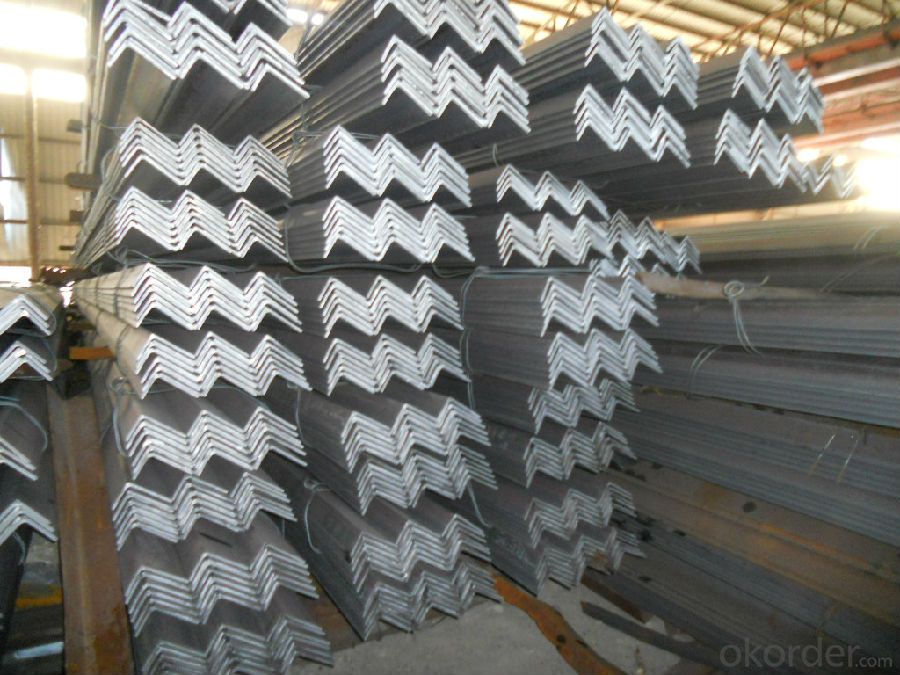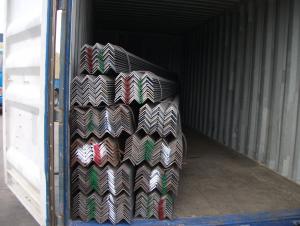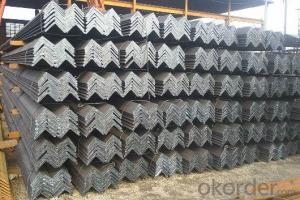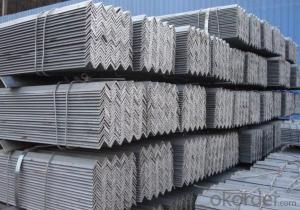Structure Steel Hot Rolled Angle Bar
- Loading Port:
- China Main Port
- Payment Terms:
- TT or LC
- Min Order Qty:
- -
- Supply Capability:
- -
OKorder Service Pledge
OKorder Financial Service
You Might Also Like
Product Description:
OKorder is offering Structure Steel Hot Rolled Angle Bar at great prices with worldwide shipping. Our supplier is a world-class manufacturer of steel, with our products utilized the world over. OKorder annually supplies products to European, North American and Asian markets. We provide quotations within 24 hours of receiving an inquiry and guarantee competitive prices.
Product Applications:
Trusses;
Transmission towers;
Telecommunication towers;
Bracing for general structures;
Stiffeners in structural use.
Product Advantages:
OKorder's Structure Steel Hot Rolled Angle Bar are durable, strong, and resist corrosion.
Main Product Features:
· Premium quality
· Prompt delivery & seaworthy packing (30 days after receiving deposit)
· Corrosion resistance
· Can be recycled and reused
· Mill test certification
· Professional Service
· Competitive pricing
Product Specifications:
1.Standards:GB,ASTM,BS,AISI,DIN,JIS
2.Invoicing on theoretical weight or actual weight as customer request
3.Material: JIS G3192,SS400;SS540.
4. Payment terms:
1).100% irrevocable L/C at sight.
2).30% T/T prepaid and the balance against the copy of B/L.
3).30% T/T prepaid and the balance against L/C
5.Sizes:

EQUAL ANGLES SIZES |
| ||
a(mm) | a1(mm) | thickness(mm) | length |
25 | 25 | 2.5---3.0 | 6M/12M |
30 | 30 | 2.5---4.0 | 6M/12M |
38 | 38 | 2.5 | 6M/12M |
38 | 38 | 3.0---5.0 | 6M/12M |
40 | 40 | 3.0---6.0 | 6M/12M |
50 | 50 | 3 | 6M/12M |
50 | 50 | 3.7---6.0 | 6M/9M/12M |
60 | 60 | 5.0---6.0 | 6M/9M/12M |
63 | 63 | 6.0---8.0 | 6M/9M/12M |
65 | 65 | 5.0---8.0 | 6M/9M/12M |
70 | 70 | 6.0---7.0 | 6M/9M/12M |
75 | 75 | 5.0---10.0 | 6M/9M/12M |
80 | 80 | 6.0---10.0 | 6M/9M/12M |
90 | 90 | 6.0---10.0 | 6M/9M/12M |
100 | 100 | 6.0---12.0 | 6M/9M/12M |
120 | 120 | 8.0-12.0 | 6M/9M/12M |
125 | 125 | 8.0---12.0 | 6M/9M/12M |
130 | 130 | 9.0-12.0 | 6M/9M/12M |
140 | 140 | 10.0-16.0 | 6M/9M/12M |
150 | 150 | 10---15 | 6M/9M/12M |
160 | 160 | 10---16 | 6M/9M/12M |
180 | 180 | 12---18 | 6M/9M/12M |
200 | 200 | 14---20 | 6M/9M/12M |
Packaging & Delivery of Angle Steel
1. Transportation: the goods are delivered by truck from mill to loading port, the maximum quantity can be loaded is around 40MTs by each truck. If the order quantity cannot reach the full truck loaded, the transportation cost per ton will be little higher than full load.
2. With bundles and load in 20 feet/40 feet container, or by bulk cargo, also we could do as customer's request.
3. Marks:
Color mark: There will be color marking on both end of the bundle for the cargo delivered by bulk vessel. That makes it easily to distinguish at the destination port.
Tag mark: There will be tag mark tied up on the bundles. The information usually including supplier logo and name, product name, made in China, shipping marks and other information request by the customer.


FAQ:
Q1: Why buy Materials & Equipment from OKorder.com?
A1: All products offered byOKorder.com are carefully selected from China's most reliable manufacturing enterprises. Through its ISO certifications, OKorder.com adheres to the highest standards and a commitment to supply chain safety and customer satisfaction.
Q2: How do we guarantee the quality of our products?
A2: We have established an advanced quality management system which conducts strict quality tests at every step, from raw materials to the final product. At the same time, we provide extensive follow-up service assurances as required.
Q3: How soon can we receive the product after purchase?
A3: Within three days of placing an order, we will begin production. The specific shipping date is dependent upon international and government factors, but is typically 7 to 10 workdays.
- Q: Can steel angles be used for modular furniture or fixtures?
- Certainly, modular furniture or fixtures can definitely utilize steel angles. These robust and adaptable structural components can be seamlessly incorporated into the design of modular furniture. They contribute stability and reinforcement to the overall structure, resulting in furniture pieces that are not only resilient but also long-lasting. Steel angles can serve as corner brackets or supports for shelves, cabinets, or other modular elements. They can be effortlessly tailored to meet specific design criteria through cutting, welding, or drilling, thus granting the freedom to create various configurations or sizes of modular furniture. Furthermore, steel angles can be powder coated or painted in a variety of colors to match the desired visual appeal of the furniture or fixtures. The utilization of steel angles in modular furniture or fixtures guarantees durability and longevity. They exhibit resistance to wear and tear, corrosion, and impact, rendering them suitable for both indoor and outdoor applications. Additionally, steel angles are readily available and cost-effective, making them a pragmatic choice for the manufacturing of modular furniture or fixtures. To summarize, steel angles are an outstanding option for the creation of modular furniture or fixtures due to their potency, versatility, and endurance. They lend stability and support to the structure, can be conveniently tailored, and deliver sustained performance. Whether for residential or commercial purposes, steel angles can be employed to fashion modular furniture or fixtures that are both functional and visually appealing.
- Q: What are the different methods of surface finishing for steel angles?
- There are several different methods of surface finishing for steel angles, each with its own advantages and considerations. The most common methods include painting, galvanizing, powder coating, and shot blasting. Painting is a popular method for surface finishing steel angles as it provides a protective barrier against corrosion and adds an aesthetic appeal. The angle is typically cleaned and primed before applying multiple coats of paint. This method allows for a wide range of color options and can be easily touched up if damaged. Galvanizing involves coating the steel angle with a layer of zinc to protect it from corrosion. This method is particularly effective in harsh environments where the angle may be exposed to moisture or chemicals. Hot-dip galvanizing is the most common method, where the angle is immersed in a bath of molten zinc. This creates a durable and long-lasting finish that requires minimal maintenance. Powder coating is another popular surface finishing method that involves applying a dry powder to the angle and then curing it with heat to form a protective layer. This method offers excellent durability and resistance to corrosion, chemicals, and UV rays. It also provides a smooth and consistent finish, with a wide range of colors available. Shot blasting is a mechanical method of surface finishing that involves blasting the steel angle with high-speed abrasive particles. This removes any rust, mill scale, or other contaminants from the surface, resulting in a clean and smooth finish. Shot blasting also creates a rough texture that improves paint adhesion, making it an ideal pre-treatment before painting or powder coating. It is important to consider the specific requirements of the steel angle's application when choosing a surface finishing method. Factors such as the environment, expected lifespan, aesthetic preferences, and budget should all be taken into account. Consulting with a professional or the steel manufacturer can help determine the most suitable method of surface finishing for steel angles in a particular situation.
- Q: How do steel angles differ from other structural shapes?
- Steel angles differ from other structural shapes in several ways. Firstly, steel angles have a distinct L-shaped cross-section, with two perpendicular flanges and a central web connecting them. This unique shape provides the angle with exceptional strength and load-bearing capacity, making it suitable for various structural applications. Secondly, steel angles are highly versatile and can be used in a wide range of construction projects. They can be easily welded, bolted, or screwed together to create complex structures such as frames, supports, and bracings. This flexibility makes them a preferred choice for engineers and architects. Moreover, steel angles are available in different sizes and thicknesses, allowing for customization based on specific project requirements. This variety in dimensions makes it easier to achieve the desired strength and stability in structural designs. Additionally, steel angles offer cost-effective solutions compared to some other structural shapes. Their efficient use of materials and manufacturing processes make them relatively affordable while still maintaining their durability and functionality. Lastly, steel angles can withstand significant loads and stresses, making them ideal for applications where structural integrity is crucial. Their ability to distribute weight evenly across the flanges and web ensures stability and prevents deformation under heavy loads. In summary, steel angles are unique structural shapes that provide strength, versatility, customizability, cost-effectiveness, and durability. These features make them an excellent choice for various construction projects, setting them apart from other structural shapes.
- Q: What are the different types of steel angles used in bridge construction?
- Bridge construction commonly utilizes various types of steel angles that serve vital roles in providing structural support and stability to the bridge. 1. Equal Leg Angles, also referred to as L-shaped angles, possess two legs of equal length forming a 90-degree angle. These angles support and reinforce the bridge components during construction. 2. Unequal Leg Angles, as implied, have two legs of different lengths forming a 90-degree angle. These angles are frequently employed in bridge construction to accommodate specific design requirements and support varying loads. 3. Bulb Angles are unique angles characterized by a bulb-shaped leg. They enhance the strength and rigidity of the bridge structure, particularly in areas expected to experience high stress or heavy loads. 4. Inverted Angles are similar to equal leg angles, but their orientation is inverted, with the longer leg positioned at the bottom. These angles provide additional support and stability, especially when the bridge must withstand lateral forces. 5. Fillet Welded Angles are angles joined together using fillet welds. Their purpose in bridge construction is to establish robust and durable connections between different bridge components, ensuring structural integrity and stability. Each steel angle type possesses distinct properties and advantages, rendering them suitable for specific applications in bridge construction. The selection of the appropriate angle type depends on factors such as load requirements, span length, design specifications, and structural considerations. Professional engineers and designers diligently evaluate these factors to determine the most suitable steel angle for a given bridge construction project.
- Q: Are steel angles suitable for reinforcing concrete structures?
- Yes, steel angles are suitable for reinforcing concrete structures. Steel angles are commonly used in construction as they provide strength, stability, and support to concrete structures. By adding steel angles to reinforce concrete, the overall structural integrity of the building or structure is enhanced, ensuring its durability and resistance to various loads and forces.
- Q: What is a steel angle?
- A steel angle, also known as an angle iron or L-shaped bar, is a structural steel product that features two perpendicular legs joined together at a 90-degree angle. It is commonly used in construction and engineering applications as a support or reinforcement for various structures due to its strength and versatility. Steel angles are typically made from carbon steel or stainless steel and come in various dimensions, thicknesses, and lengths to suit different project requirements. They can be easily cut, welded, and bolted, making them a popular choice for framing, bracing, and supporting beams, columns, and other structural elements. Additionally, steel angles are also frequently utilized in the manufacturing of shelves, brackets, frames, and other metalwork applications.
- Q: What are the design considerations for using steel angles in architectural applications?
- Some design considerations for using steel angles in architectural applications include structural stability, load-bearing capacity, aesthetic appeal, corrosion resistance, and ease of installation. Steel angles are commonly used to provide support, reinforcement, and stability to various architectural elements such as beams, columns, and frames. The selection of the appropriate size, thickness, and grade of steel angle is crucial to ensure the structural integrity and safety of the building. Additionally, architects may consider the visual impact of steel angles, as they can be exposed or concealed depending on the design intent. The corrosion resistance properties of the steel angles should also be taken into account, especially in applications where exposure to moisture or harsh environments is expected. Lastly, the ease of installation and compatibility with other building materials should be considered to streamline the construction process.
- Q: What is the minimum bend radius for a steel angle?
- The minimum bend radius for a steel angle depends on the specific dimensions and thickness of the angle. It is generally recommended to consult the manufacturer or reference industry standards to determine the appropriate minimum bend radius for a particular steel angle.
- Q: How do steel angles contribute to LEED certification?
- There are several ways in which the use of steel angles can contribute to LEED certification, which is the Leadership in Energy and Environmental Design. Firstly, the production of steel angles often involves the use of recycled steel, reducing the need for new materials and lessening the environmental impact of steel production. Secondly, steel angles have a long lifespan and are highly durable, resulting in reduced maintenance and replacement needs. This, in turn, leads to a decrease in waste generated throughout a building's lifecycle, thus earning LEED credits for minimizing construction and demolition waste. Furthermore, steel angles can be utilized to create efficient structural systems that allow for open and adaptable building designs. This aspect qualifies for LEED recognition in the Innovation in Design category, highlighting exceptional energy and resource efficiency. Additionally, integrating steel angles into a building's design is a straightforward process, making it easier to support sustainable features like solar panels, green roofs, or rainwater harvesting systems. These environmentally friendly features are instrumental in achieving LEED credits for energy efficiency, renewable energy, and water efficiency. In conclusion, the utilization of steel angles in construction contributes to LEED certification through their use of recycled materials, provision of durability and longevity, facilitation of efficient structural systems, and support for sustainable features integration.
- Q: What are the considerations for selecting the appropriate steel angle thickness?
- When considering the appropriate thickness for a steel angle, there are multiple factors to take into account. Firstly, the project's structural requirements are of utmost importance. This includes assessing the load-bearing capacity, support requirements, and adherence to specific design codes or standards. The chosen steel angle thickness should guarantee the structural integrity of the project. The application of the steel angle also plays a crucial role in determining the suitable thickness. Different applications have varying demands in terms of strength, durability, and resistance to environmental factors. For instance, if the steel angle will be used in a corrosive environment, a thicker thickness may be necessary to provide enhanced protection against corrosion. Cost-effectiveness is always a significant consideration in construction projects. While thicker steel angles may offer greater strength and stability, they can also be more expensive. Striking a balance between the required strength and the available budget is essential for ensuring cost-effectiveness. Furthermore, the selected steel angle thickness should align with the manufacturing and fabrication capabilities of the manufacturer. It is important to consider the availability of the desired thickness and the feasibility of producing the required dimensions. In some cases, the appearance of the steel angle may also be a factor to consider. Thicker angles can have a more substantial and visually appealing look, which can be desirable in certain architectural or design applications. The availability of steel angles in different thicknesses and standard sizes can also influence the selection process. Opting for a thickness that is readily available in the market is often more convenient and cost-effective. To conclude, selecting the appropriate steel angle thickness involves careful consideration of structural requirements, application demands, cost-effectiveness, manufacturing limitations, aesthetic preferences, and the availability of standard sizes. By taking all these factors into account, an informed decision can be made to meet the project's needs and ensure the desired level of strength and durability.
Send your message to us
Structure Steel Hot Rolled Angle Bar
- Loading Port:
- China Main Port
- Payment Terms:
- TT or LC
- Min Order Qty:
- -
- Supply Capability:
- -
OKorder Service Pledge
OKorder Financial Service
Similar products
Hot products
Hot Searches
Related keywords



























